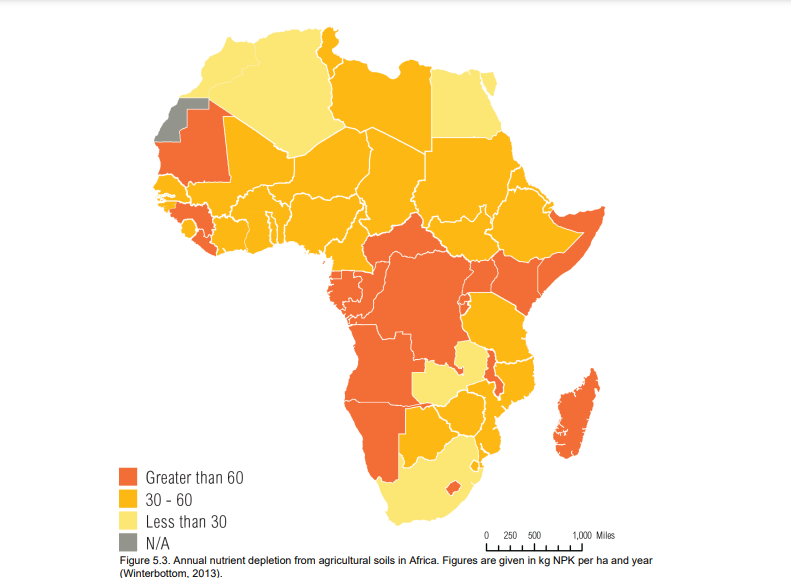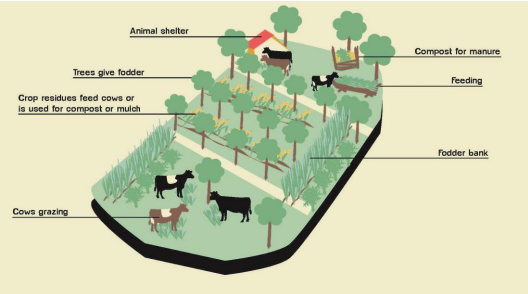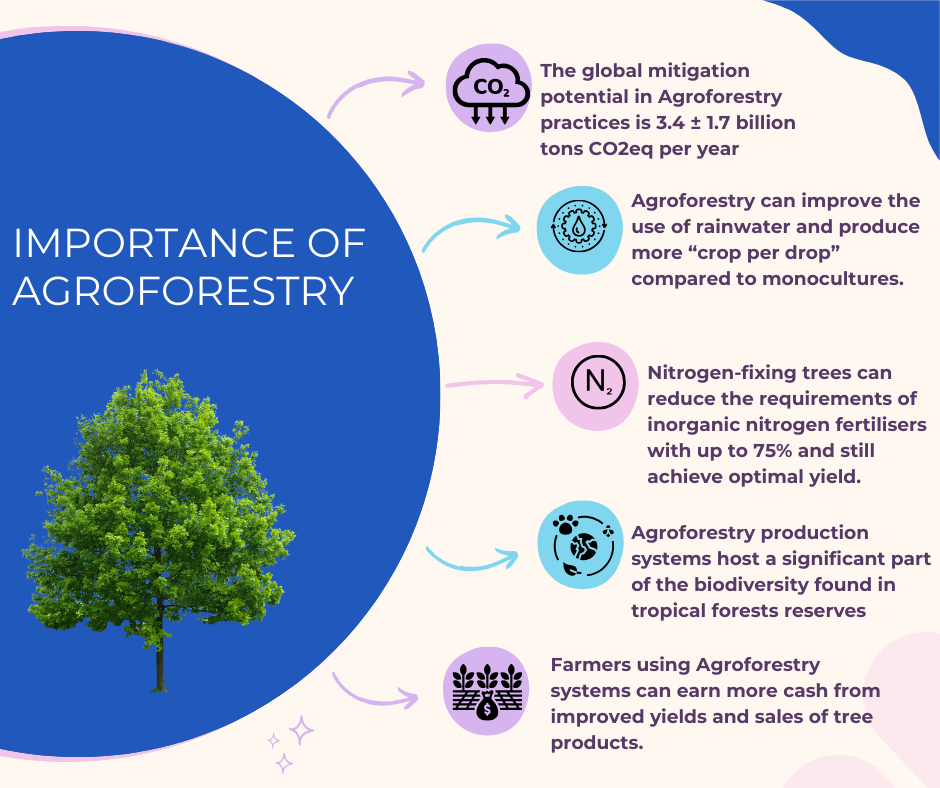Contact: +91 99725 24322 |
Menu
Menu
Quick summary: Explore the synergy between agroforestry in Africa and EU sustainability goals in our insightful blog. Uncover how innovative farming practices contribute to environmental conservation, aligning with the EU's vision for sustainable agriculture. Dive into the transformative journey of agroforestry, promoting resilience and biodiversity while addressing global sustainability objectives.

Fulfilling the policy objective of achieving sustainable agricultural production, which encompasses climate change mitigation, adaptation, and biodiversity preservation, requires striking a balance with farm productivity, socio-economic viability, and broader sustainability goals. In the vast landscapes, where the heartbeat of agriculture echoes through communities, Agroforestry in Africa holds the potential to enhance ecosystem services, such as soil carbon sequestration, water retention, erosion control, nutrient cycling, pollination, and pest- and disease-control, all while contributing to increased biodiversity.
Small-holder farmers with less than 2 ha produce 30-34% of the world’s food, and farms with less than 5 ha between 44–48%. Agroforestry, where trees are integrated with crops and/or livestock, is a promising land management system that can address many of the challenges farmers are facing.
About one third of the global greenhouse gas emissions are recorded from human activities and are from agriculture. To meet the rising demand of food production with growing world population, agriculture has for most of the 20th century focused on commercial practice. Agroforestry is turning that approach around by choosing instead to work with nature.
This blog post focusses on a journey deep into the roots of Agroforestry in Africa, unraveling its profound significance in addressing both environmental and social challenges. As we delve further, we’ll uncover the interconnectedness between Agroforestry and the ambitious EU Sustainability Goals, forging a path toward a greener and more resilient future.
There is a growing global concern regarding environmental deterioration in sub-Saharan Africa and its potential impact on the continent’s economic prospects. The majority of Africa’s population still resides in rural areas and relies heavily on agriculture for livelihoods. The rapid growth in population, coupled with limited advancements in agricultural technology, has intensified the strain on Africa’s finite arable lands. This pressure has led to shortened fallow cycles and the expansion of cultivation onto unsuitable or marginal lands. Additionally, the escalating population demands for fuelwood, construction materials, and other resources traditionally sourced from natural vegetation have further fueled deforestation. This trend has triggered an increase in wind and water erosion and a decline in agricultural land productivity, forming a concerning cycle of environmental degradation.

Confronted with this challenge, African governments and external donors have endeavored to counteract the ongoing process of environmental degradation. Their efforts are twofold: preserving the fertility of agriculturally productive regions and revitalizing the productivity of degraded lands. The scale of this undertaking is immense, with approximately 750 million hectares of land in Africa, equivalent to about one-quarter of the total landmass, estimated to have either lost or currently be losing its productive capacity. Recognizing that the removal of trees and vegetation is a significant contributor to land degradation, recent focus has shifted towards understanding the role of trees in African agriculture. There is a growing interest in exploring the potential of restoring soil fertility and enhancing land productivity by integrating trees and tree products with crops and/or livestock in what is known as agroforestry systems.
Agroforestry, at its essence, is exploring the symbiotic relationship between trees and crops. We explore the art of tree planting and species selection, understanding how these decisions shape not just landscapes but entire ecosystems. The importance of cultivating diversity in harmony becomes apparent, fostering resilience, enhancing soil health, and providing a haven for biodiversity.
The harmonious integration of trees with agricultural crops is a testament to the ingenuity of Agroforestry. We unravel the intricate relationships between these elements, showcasing how this integrated approach becomes a catalyst for improved soil fertility, reduced erosion, and heightened crop yields. It’s a dance in the fields where every partner benefits.
Discover the transformative advantages of agroforestry!
Explore the four key benefits that make agroforestry a sustainable game-changer for farmers and the environment.
Dive into our blog
Agroforestry extends beyond the boundaries of ecological gains. Here, we delve into the often overlooked socioeconomic benefits, revealing how Agroforestry empowers local communities by providing alternative income streams, fostering community cohesion, and contributing to poverty alleviation. It’s not just about trees and crops; it’s about people.

The European Union (EU) has some big goals to make the world a better and more sustainable place. Think of these goals like a set of important promises. One of these promises is to take good care of the environment, making sure we use our resources wisely and don’t harm the planet.
Now, Agroforestry is like a superhero helping the EU keep these promises. Imagine a farmer’s field with not just crops but also trees. These trees do more than just provide shade; they work together with the crops in a special way.

1. Growing Together: Agroforestry is like teamwork between trees and crops. The trees help the crops grow better and vice versa. It’s like having buddies in the field, and together, they make everything more robust and healthy.
2. Nature’s Clean-Up Crew: The EU wants to reduce the bad stuff in the air, like the carbon dioxide that makes the planet warmer. Agroforestry is like nature’s clean-up crew. The trees absorb this carbon dioxide and store it, making the air cleaner and helping fight climate change.
3. Biodiversity Boost: Biodiversity is like having a variety of different plants and animals, making the world more interesting and balanced. Agroforestry supports this by creating a home for different species. It’s like inviting more friends to the party, making nature richer and more vibrant.
4. Protecting the Soil: The EU wants to take care of the soil so that it stays healthy. Agroforestry is like a superhero for the soil. The tree roots help prevent soil erosion, keeping everything in place and making sure the soil stays fertile for growing crops.
Let’s delve into some fascinating stats that paint a vivid picture of its impact:
The World Agroforestry Centre estimates that widespread adoption of agroforestry practices could restore up to 2 billion hectares of degraded land. This would be a game-changer for environmental restoration, food security, and climate change mitigation.
Implementing comprehensive education and outreach programs is crucial. These initiatives should not only highlight the environmental benefits but also emphasize the economic advantages of agroforestry. Demonstrations, workshops, and community engagement activities play a pivotal role in dispelling myths and building confidence in adopting new and sustainable practices.
Anticipated to reach 9.7 billion by 2050, the global population surge intensifies the imperative of achieving zero hunger, ensuring universal access to ample, safe, and nutritious food.
The key to realizing this goal lies in implementing resilient and productive farming practices, aligning with the ambitions of Sustainable Development Goal 2.
One of the notable economic benefits of agroforestry lies in its ability to grant farmers access to premium markets. Many consumers today are seeking products with a sustainability stamp, and agroforestry provides just that. Through adhering to sustainable practices, farmers can secure certifications that open doors to markets willing to pay a premium for responsibly sourced products.
Certification is not just a label; it’s a key that unlocks opportunities for farmers to reach consumers who prioritize environmentally friendly and socially responsible products. This access to premium markets not only elevates the economic standing of farmers but also encourages the continuation of sustainable practices.
As agroforestry practices continue to gain recognition and support, the economic benefits will not only sustain individual farmers but also contribute to the overall economic resilience of regions.
By harnessing technology solutions, African farmers can overcome challenges, enhance the efficiency of their agroforestry initiatives, and contribute to sustainable agriculture and environmental conservation. Advanced technologies, such as GPS-guided equipment and drones, enable precise planning and management of agroforestry plots. This ensures optimal placement of trees, efficient resource use, and improved overall productivity. Access to real-time climate data helps farmers make informed decisions about tree species selection and planting times, considering changing weather patterns. Mobile applications can provide farmers with valuable information on agroforestry practices, crop management, and market trends. This facilitates knowledge sharing, empowering farmers to make better decisions. Satellite imagery and remote sensing technologies assist in monitoring the health and growth of trees in agroforestry systems. Implementing blockchain technology ensures transparent and traceable supply chains. This is particularly important for agroforestry products, allowing farmers to showcase the sustainability of their practices and potentially access premium markets. Analyzing data on soil health, crop performance, and market trends allows farmers to make data-driven decisions, optimizing agroforestry practices for both environmental sustainability and economic viability.
The TraceX DMRV platform emerges as a transformative ally for agroforestry initiatives in Africa. By integrating blockchain traceability, it ensures transparency and accountability throughout the supply chain. Farmers using TraceX can showcase the sustainability of their agroforestry practices, fostering trust among consumers and potentially accessing premium markets. TraceX DMRV stands as a technological cornerstone, facilitating the adoption and scalability of agroforestry practices in the pursuit of sustainable and resilient farming systems.
A significant majority of Malawi’s population, constituting three-quarters of its 13 million people, are classified as smallholder farmers, with a substantial portion facing food insecurity. In response to this challenge, the World Agroforestry Centre (ICRAF) has initiated an agroforestry program within the country, aiming to tackle various facets of food security.
In East Africa, the daily fruit intake stands at just 35 grams, falling significantly short of the recommended 400 grams per day. Agroforestry plays a crucial role in enhancing nutritional security by diversifying crops, thereby offering farmers access to a more varied and balanced diet.
Kenya Agricultural Carbon Project (KACP) achieved certification for its initial carbon credits under the Verified Carbon Standard (VCS, now Verra). Originally established through a collaboration between the Swedish NGO (Vi Agroforestry), the World Bank’s BioCarbon Fund, and UNIQUE forestry and land use, the project is executed by Vi Agroforestry. Rooted in Sustainable Agricultural Land Management (SALM) practices, the initiative synergizes climate mitigation, adaptation, and enhanced productivity. Spanning 21,965 hectares in western Kenya, the KACP encompasses 1,730 farmer groups and benefits 29,497 smallholder farmers.
Over the last two decades, there has been remarkable progress in two regions bordering the southern fringes of the Sahara. Approximately 5 million hectares of degraded farmland have undergone a transformative change with the introduction of trees and bushes, leading to the restoration of both the environment and the well-being of farmers. Research indicates a substantial increase in yields in the area. Moreover, farmers with extensive experience in agroforestry demonstrate better resilience to climate change compared to those who are new to the system.
The success stories of agroforestry initiatives in Africa are not the culmination but rather the beginning of a transformative journey. Scaling up these initiatives is paramount to ensuring their widespread adoption and long-term impact across the African continent.
Agroforestry in Africa has the potential to align seamlessly with the sustainability goals of the European Union (EU). Exploring opportunities for collaboration not only strengthens the bond between continents but also creates a collective impact on global environmental and social challenges.
It becomes evident that agroforestry is not merely a farming practice; it is a holistic approach that nurtures the land, empowers communities, and addresses the global challenges of our time. From the roots firmly planted in African soil to the collaborative branches reaching towards European sustainability goals, agroforestry is a living testament to the power of collective action.
The echoes of this journey resonate through the leaves, in the winds of change that carry the stories of successful initiatives, the challenges overcome, and the opportunities seized. It’s a call to sustain the green revolution, not just through words but through sustained efforts, innovation, and a shared commitment to a resilient and sustainable future.
